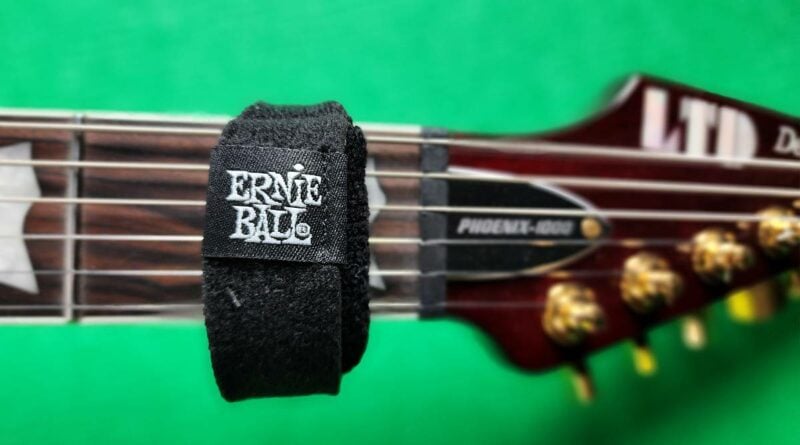What are string dampeners? Can they help your playing? You may have seen dampeners out in the real world or read about how players are using them to improve their sound. Or maybe this is the first time you’re hearing about this very simple, very useful guitar accessory.
Dampeners are not a typical part of the guitar player’s arsenal, so to many they’re something of a curiosity. In this article, we’ll focus on what dampeners are and how you can use them to improve your playing. By the end of this guide, you should have a good idea what these things do and whether they’re right for you.
Contents
- What are String Dampeners?
- How Do I Use A Dampener?
- String Dampeners vs. Fretwraps
- What’s the Best Guitar Fretwrap?
- Do Guitar Dampeners Come in Different Sizes?
- Do Guitar Fretwraps Work?
- When Should I Use a Guitar Fretwrap?
- Am I Cheating If I Use a Fretwrap?
- Are There Bass String Dampeners?
- Can I Make My Own?
- Why Should I Use A Fretwrap?
- When Should You Use a Guitar Fretwrap?
- Are There Different Types of Dampeners?
- Final Thoughts
What are String Dampeners?
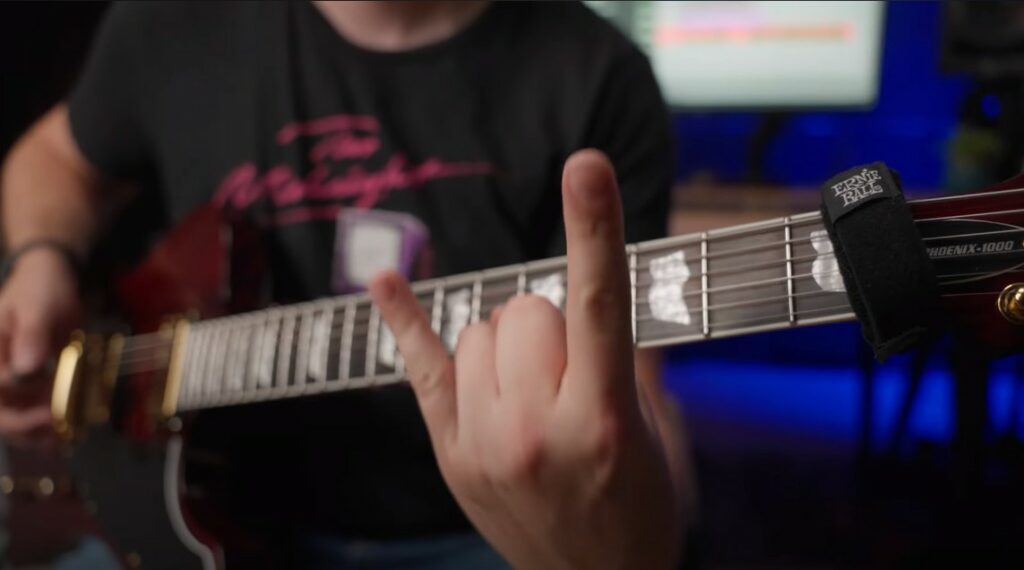
A string dampener is a strap-like accessory that usually goes over the neck of the instrument in order to quiet the sound of open strings during playing. It is typically used when playing notes further up on the neck, in order to avoid excess noise from open strings. Most dampeners are inexpensive and can be made from a variety of materials, including velcro and cloth.
When dampeners are working effectively, the result is a cleaner tone and clearer notes.
How Do I Use A Dampener?
Guitarists typically wrap a their dampener around the neck at the first or second fret. The dampener goes all the way around the neck, like a cuff or collar. This allows the player to use the higher frets easily.
Velcro fretwraps are pretty easy to remove on the fly if you want to get back to playing with all frets available. Many players will slide them up onto the headstock so they’re available to use again at a moment’s notice.
String Dampeners vs. Fretwraps
Some musicians refer to guitar dampeners as fretwraps or string dampeners. These terms are interchangeable. We’ll be using the words interchangeably in this article as well, so don’t get confused! It’s all the same thing.
What’s the Best Guitar Fretwrap?
If you’re looking for a more do-it-yourself approach and don’t want to spend any money, the best homemade fretwrap is a common hair tie. That’s right, you read that correctly. A hair tie. Wrap a hair tie around the neck of your guitar and you’ll be surprised how well it does at dampening noise. In a pinch, you could also use a scrunchy too, as long as it fits securely around the neck. These aren’t the most elegant solutions, but they get the job done.
If you’re looking for something a little more legit, you can’t go wrong with GruvGear FretWraps. These are pretty much the best standard fretwrap on the market because they include extra padding that allows you to control the strings even more. They aren’t too expensive, so pick one up next time you’re at your local guitar shop to see if they work for you.
There’s one other common option in the world of string dampeners, and that’s the MAB string dampener, designed by legendary guitarist Michael Angelo Batio. These may just be the best designed fretwraps on the market, but they are definitely on the more expensive side. One MAB dampener costs roughly the same as three 3-packs of GruvGear FretWraps. If you have that kind of money to throw around, go for it. But most people will be just fine with the GruvGear FretWraps (or hair ties).
Do Guitar Dampeners Come in Different Sizes?
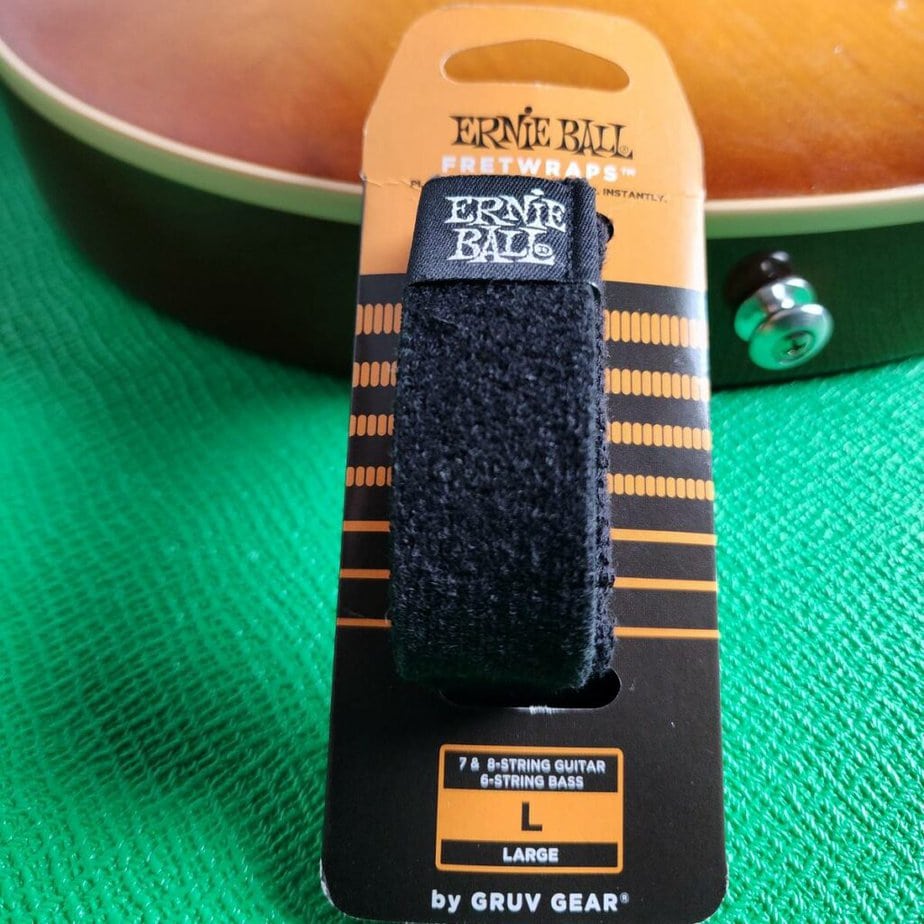
Dampeners come in a number of sizes, which correspond to the size of the instrument’s neck and may vary depending on the manufacturer. In general, larger sizes are better suited to larger necks like classical guitars and basses.
It’s best to consult the manufacturer’s website before buying a dampener for your guitar. Better yet, try one out in your local guitar shop to make sure it’s a good fit. The important thing to remember is that dampeners come in a variety of different sizes and one size definitely doesn’t fit all.
Do Guitar Fretwraps Work?
Fretwraps/Dampeners do a great job of eliminating unwanted noise on open strings. This kind of noise is inevitable due to the construction of the guitar.
Because the strings are packed so tightly together and because guitarists are reliant on their picking hand to mute unwanted string noise, sometimes unwanted noise “bleeds” in while playing. This phenomenon of sound bleeding in when it is unwanted is called sympathetic resonance. You might not notice this at first, but it’s there and happens for almost all people playing the guitar.
To confirm whether your strings are creating unwanted noise, do a simple test. You can hear sympathetic resonance pretty much any time you pick up a guitar and play a note. When you play a note on one string, you will often hear another string ringing out faintly. For some musicians, this doesn’t matter that much, but others would prefer to eliminate that type of noise. That’s where dampeners come in.
As with most things on the guitar, the louder the volume, the worse the problem is. This is why dampeners tend to be used by people playing certain types of music, like heavy metal. Strings begin vibrating uncontrollably at high volumes due to feedback from the amp. If you’re in the middle of a tapping solo, you may not have a chance to mute them.
Sympathetic resonance isn’t a problem on some string instruments like the piano, where there is often a special pedal for dampening notes. But luckily, for guitarists, there is a solution. That solution is the fretwrap.
When Should I Use a Guitar Fretwrap?
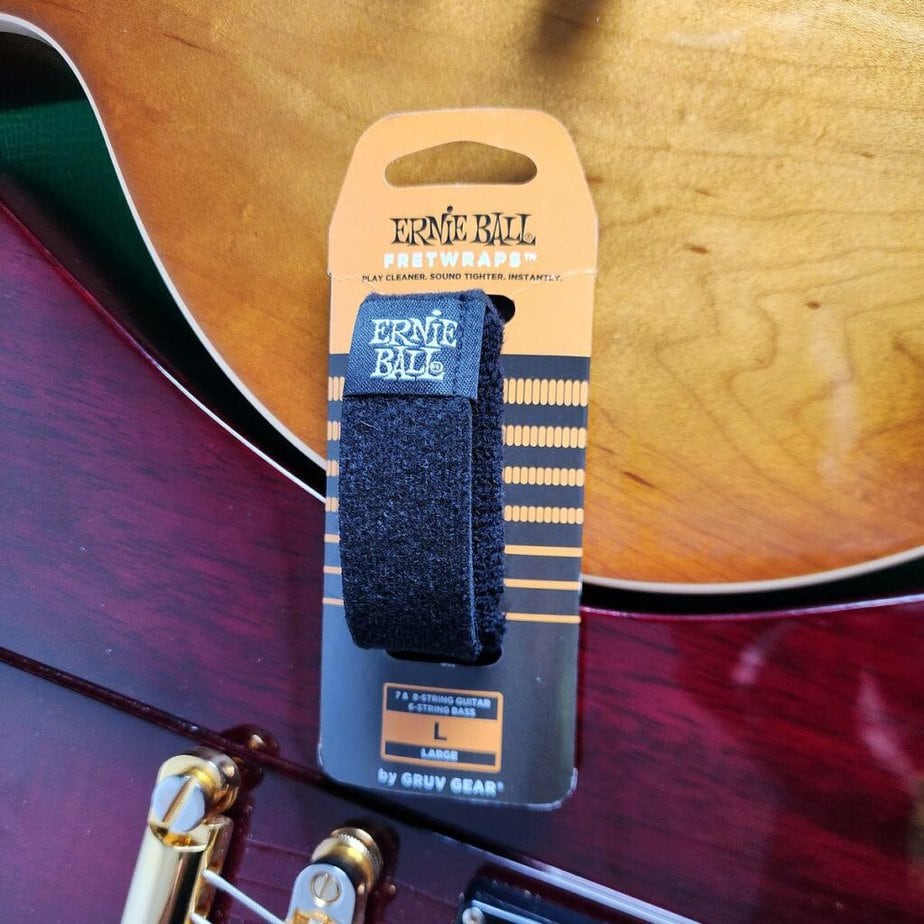
Whether you should use a guitar fretwrap depends on what type of music you’re playing and whether or not open string noise is causing you trouble.
A good way to test whether you need a guitar string dampener is by recording yourself playing. Do you hear open string notes where you shouldn’t? Are you getting unwanted feedback when playing an electric guitar? If the answer to these questions is yes, you might want to look into buying a guitar fretwrap.
Many guitarists use a dampener for important lead parts while playing live. Playing a blisteringly-fast lead solo with your amp cranked up can definitely be a challenge. With a dampener in place, you will be less stressed and can focus more on the music.
One thing to remember is that guitar string dampeners aren’t always easy to use live. Some guitarists do it, but remember you’ll need to have time to focus on attaching the dampener and then removing it when it’s no longer needed. This can be a distraction, depending on how much you have to play and how complicated your parts are.
Some players prefer to use a fretwrap when recording. In the recording studio, it can be frustrating to do many takes of the same song while trying to play the notes correctly in a solo. A dampener can make this process easier, allowing the player to capture the right notes in one take, saving time and money.
Another great way to incorporate this accessory into your playing is by using a string dampener to practice. It can be enormously helpful to focus on one thing at a time when practicing guitar. Otherwise things can get overwhelming fast. That’s why having a dampener can be just the thing to help you hone in on achieving your practice goals.
If you’re practicing an advanced technique, like sweep picking or double stops, you might want to attach a string dampener to focus on the one skill and not have to worry about dampening your strings at the same time.
Once you have the technique down, you can remove the dampener and focus on muting the other strings.
Am I Cheating If I Use a Fretwrap?
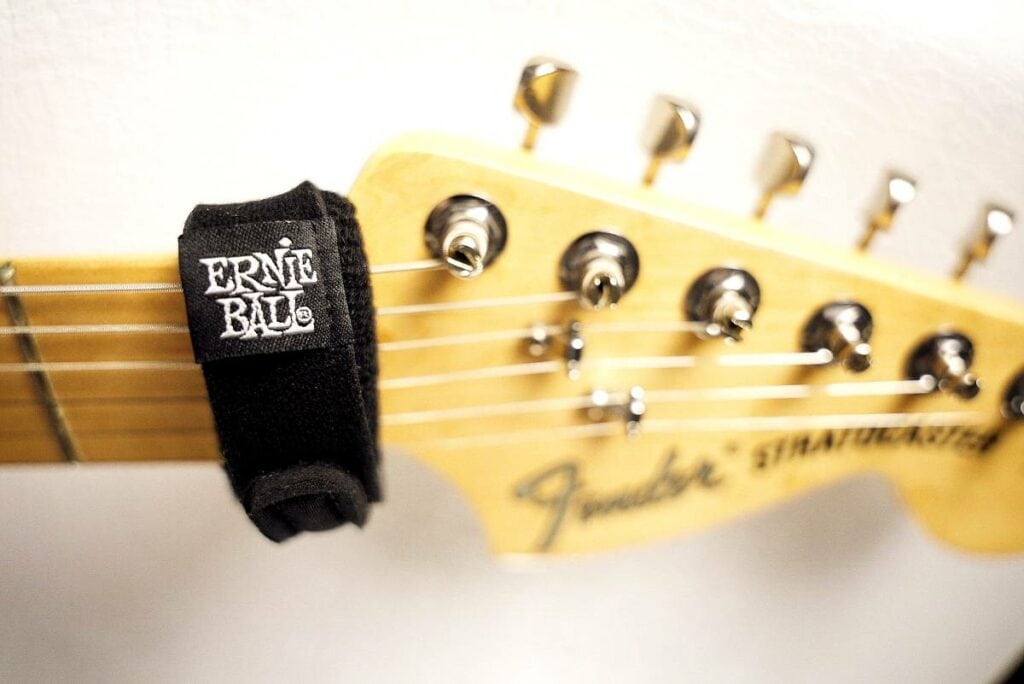
There is a debate among guitarists about dampeners. Some players consider it cheating to use one – according to these players, you should be able to mute the noise of unwanted strings on your own, as this is part of the skill of being a guitarist.
The truth is that there is no “cheating” in guitar playing. What may work for one player may not work for another. You may find yourself using guitar dampeners at the beginning of your playing career and then anymore as you progress. Or you may use them for one particularly difficult passage when recording an album and never again.
The point is, a dampener is a useful accessory to have and you should at least consider using one from time to time if excess noise is a problem.
Are There Bass String Dampeners?
Can you use your guitar dampener on a bass? Yes, as long as it fits snugly over the instrument’s neck. A dampener can be used on any instrument with a fretboard as long as it fits. That’s the major reason that manufacturers offer a variety of sizes.
The difference in size between a 6-string electric guitar and a 4-string bass isn’t that much, but think about 5- and 6-string basses and you’ll soon understand why different sizes for string dampeners are necessary.
Can I Make My Own?
You absolutely can make your own dampener using everyday household products like hair ties, rubber bands, and even scrunchies.
Like many guitar accessories, there’s no need to spend an arm and a leg on a fretwrap if a homemade solution can do the job just as well. Just be careful not to damage your axe.
Experiment with different ways to mute your guitar strings and let us know if you find something that works really well!
Why Should I Use A Fretwrap?

Here are a few reasons to use a dampener:
- To limit open string noise
- Avoid feedback at louder volumes
- Effectively play further up the neck
- Use complicated picking patterns on chords
- Stop accidentally playing lower notes
- Play with advanced techniques like tapping
- Get the chord voicings “right” for a recording or performance
Some techniques like two-handed tapping make it hard to mute the other strings while playing. For this reason, some players prefer to use a dampener specifically for those passages.
When Should You Use a Guitar Fretwrap?
The best time to use a guitar fretwrap is if you’re playing something complex that may accidentally trigger open string noise when you don’t want it. For example, heavy metal lead guitar often requires highly-skilled techniques like sweeps, alternate picking, tapping, and double stops.
If you’re playing a particularly challenging heavy metal solo, you may want to use a guitar fretwrap to make sure your guitar doesn’t generate any unwanted feedback or open string noise during the course of your playing.
Are There Different Types of Dampeners?
The most popular kind of guitar string dampener is made of polyester and velcro, but there are others made of pure plastic for larger stringed instruments that require a firmer grip for effective muting.
Final Thoughts
Fretwraps/dampeners are a great accessory. But like any other guitar string accessory, they’re just a tool to help you accomplish something. They won’t make you a better player, but they will make it easier for you to express yourself using the instrument. The rest is up to you.

